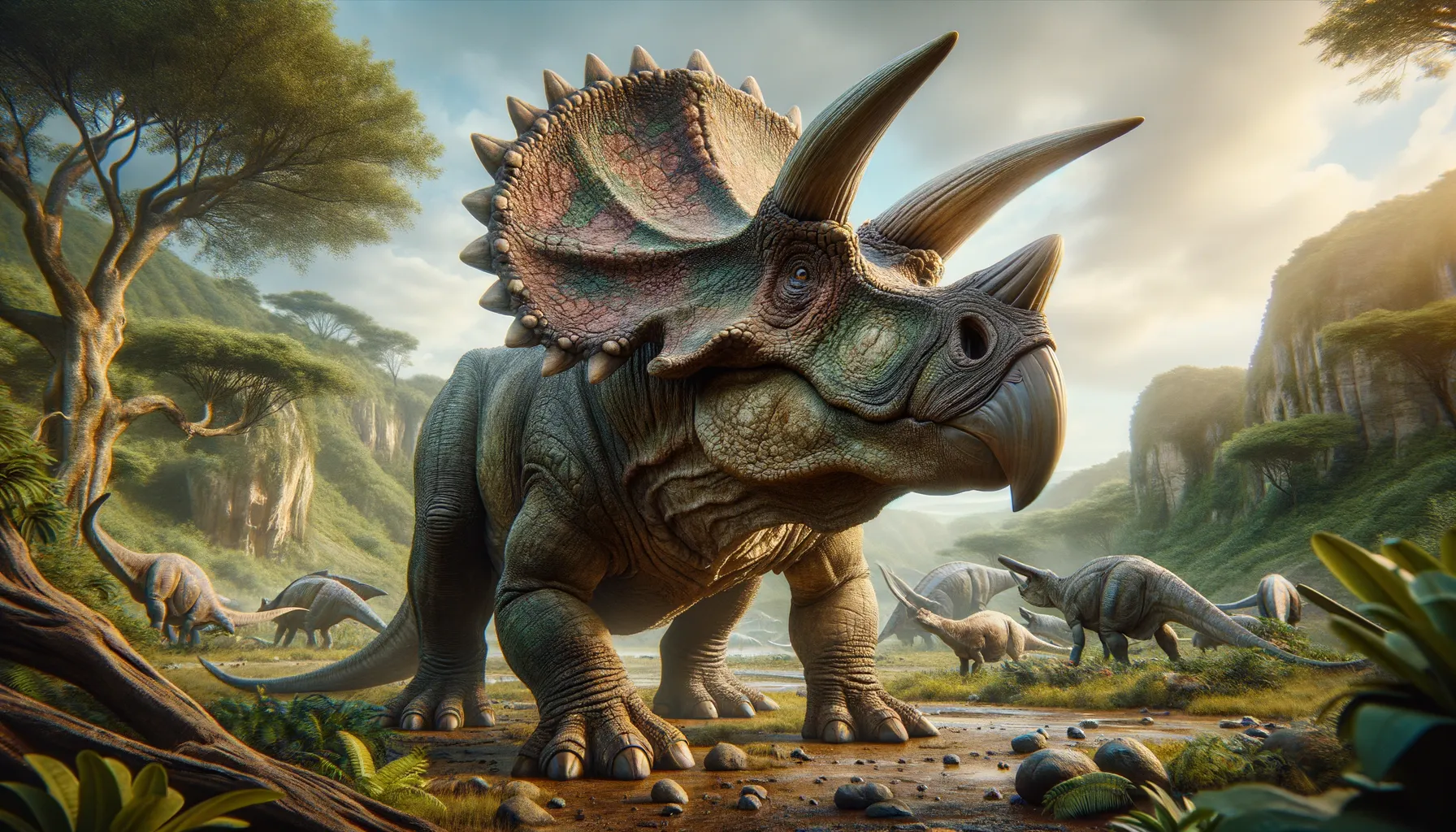
Eotriceratops
Majestic horned giant of ancient lands.
Period
Cretaceous
Length
Measured up to 30 feet in length.
Height
Reached heights of about 10 feet at the shoulders.
Weight
Estimated weight was around 10 tons.
Eotriceratops was a large ceratopsid dinosaur that roamed North America during the Late Cretaceous period. Known for its impressive frill and three distinct facial horns, it is one of the larger members of its family. This herbivore was part of complex ecosystems, coexisting with a variety of other dinosaurs and adapting to the changing environments of its era. Eotriceratops' discovery contributes significantly to our understanding of dinosaur diversity and evolution.
Diet
As an herbivore, Eotriceratops primarily feasted on low-lying plants and shrubs. Its strong beak would have been adept at cutting through tough vegetation. It likely spent much of its time grazing in large herds.
Hunting
Eotriceratops did not hunt, as it was not a carnivore. Instead, it used its size and herd behavior as defense against predators. Its horns could have been a deterrent against attackers.
Environmental challenges
Eotriceratops faced challenges such as climate fluctuations and habitat changes. The Late Cretaceous period saw varying temperatures and sea levels, which affected plant availability. Competition with other herbivores for food was also significant. Predators like tyrannosaurs posed constant threats, requiring vigilance and reliance on herd protection.
Speed
Eotriceratops was relatively slow, likely moving at a leisurely pace to graze on vegetation.
Lifespan
Lived for several decades, typical for large herbivorous dinosaurs.
First discovery
Eotriceratops was first discovered in the Horseshoe Canyon Formation, Alberta, Canada, in 2001 by a group of paleontologists.
Fun Facts
- Eotriceratops was a large herbivorous dinosaur that lived during the Late Cretaceous period, around 68 million years ago.
- Its name means 'dawn three-horned face,' reflecting its early role in the family tree of horned dinosaurs.
- Eotriceratops had a massive frill, or bony shield, at the back of its head, and three prominent facial horns.
- This dinosaur likely roamed the areas that are now Alberta, Canada, living in lush, forested environments.
- The first and only known fossil of Eotriceratops was discovered in 2001 by a team from the Royal Tyrrell Museum.
- Despite being similar to the famous Triceratops, Eotriceratops was even larger, making it one of the biggest horned dinosaurs.
- Eotriceratops is believed to have used its horns and frill for defense against predators and potentially in courtship displays.
Growth and Development
Eotriceratops grew rapidly in its early years to minimize vulnerability to predators. It likely followed a life strategy similar to other ceratopsids, where juveniles grew quickly to reach a size too large for most predators to tackle. Maturity was reached around a decade, with continual growth throughout its life.
Habitat
Eotriceratops inhabited lush, floodplain environments with abundant vegetation. Its habitat consisted of forests interspersed with open areas that supported diverse plant life. The Late Cretaceous landscape in North America provided a perfect setting for its grazing lifestyle. Seasonal changes would often influence their migratory patterns within the region.
Interaction with other species
Eotriceratops coexisted with many other dinosaur species, including both herbivores and predators. Its primary interactions were likely with other herbivores, competing for the same plant resources. Predator-prey dynamics with large carnivorous dinosaurs like tyrannosaurs were crucial, shaping its social behaviors and defensive tactics.
Natural lifespan
Eotriceratops could live up to 60 years in the wild.
Reproduction
Eotriceratops, like other dinosaurs, laid eggs to reproduce. Females would have established nesting sites in safe, concealed areas to protect the eggs from predators. Parental care may have involved guarding the nest and assisting hatchlings after birth. This behavior ensured the young's survival until they could join larger herds.
Social behaviour
Eotriceratops likely lived in herds for better protection against predators. Social interactions would have been complex, involving communication through calls and body language. The herd structure provided safety in numbers and easier access to food resources. Cooperative behavior included alerting the group of potential dangers and collective movement during migration.
Fossil locations
Fossils of Eotriceratops have been found primarily in the Horseshoe Canyon Formation in Alberta, Canada. These sites offer invaluable insight into the Late Cretaceous fauna of North America. The area's well-preserved fossils have helped paleontologists learn more about ceratopsid evolution. Future excavations may expand our knowledge of this magnificent dinosaur.
